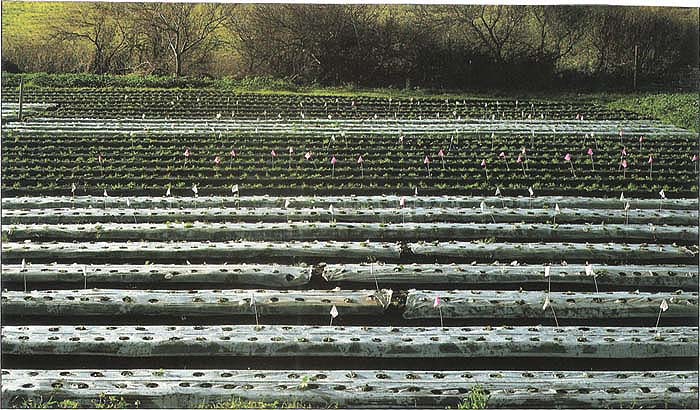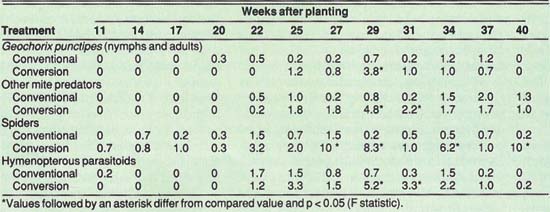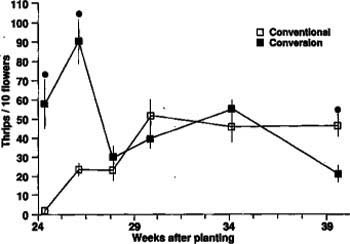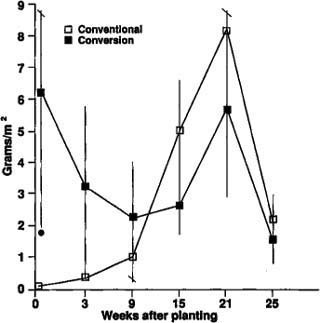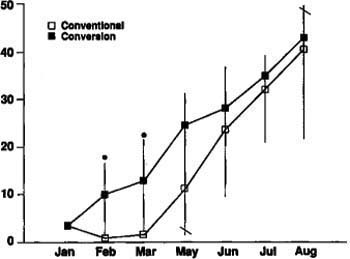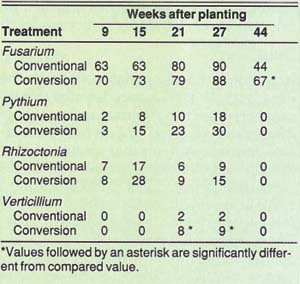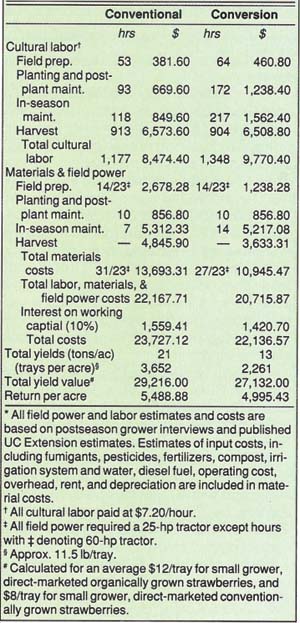All Issues
Strawberry production systems during conversion to organic management
Publication Information
California Agriculture 44(4):4-7.
Published July 01, 1990
PDF | Citation | Permissions
Abstract
Converting to a certified organic strawberry production system takes time. Growers must monitor the long-term consequences of new production factors and evaluate new cultural techniques.
Full text
California's annual strawberry crop is valued at over $300 million, and in 1989 covered more than 19,000 acres. This high-value crop has exacting cosmetic standards, and conventional production practices in California are stringent: preplant land fumigation, plastic mulching, drip irrigation, chemical control of pathogens and pest arthropods, and concentrated, semi-permanent manual labor throughout the growing season. Annual production costs may exceed $25,000 per acre. Conventional strawberry cropping is one of the most input-intensive production systems in California agriculture.
Recently, conventional strawberry production has confronted a series of problems. A key pest spider mite, Tetranychus urticae Koch, has developed resistance to most registered acaricides. At the same time, regulatory restrictions affecting the availability and frequency of use of chemical controls are on the increase. Growers continue to depend on soil fumigation and application of highly soluble inorganic nutrients. Production costs continue to rise.
However, some strawberry growers have found economic and environmental incentives that encourage them to convert their high-input production systems to practices that depend less on external inputs. These include price premiums from consumers for residue-free products, fewer regulatory restrictions on farm inputs and their off-farm impacts, and lower production costs.
With the support of the University of California's Statewide Sustainable Agriculture Research and Education Program (SAREP), the Heller Charitable Trust, and the University of California at Santa Cruz Agroecology Program, our interdisciplinary research team has developed a systems-level protocol for the simultaneous, comparative monitoring of yield-affecting variables in conventional and organic conversion farm production. We have applied our protocol to a multi-year study of the process of conversion to low-input farming practices for strawberries. Several questions confront farmers contemplating conversion to low-input, organic farming: Is strawberry production economically sustainable with reduced external inputs or organic practices? What fundamental changes in the farm system, including long-term differences in soil fertility, pest organisms, pesticide residues, yields, and profits can be expected in an organic system? Reliable answers to these questions are largely lacking from the scientific and extension literature.
Working with a small-scale strawberry grower with conventional production experience, but who has also successfully begun the transition to legally certified organic production, in fall 1987 we established annual strawberry production on a 1/2-acre plot in a randomized, complete block design with six replicates of two treatments: (1) conventionally recognized production guidelines recommended by UC Cooperative Extension, and (2) management without synthetically derived inputs in accordance with the California Health and Safety Code Section 26569. 11-.17 and the California Certified Organic Farmers guidelines and enforcement provisions.
Our principal objective was to set up experimental plots under actual farm production conditions that would permit multi-year comparison of the ecological factors and processes that influence the economic viability of transitional practices. More specific objectives included the multi-year comparison of the two production systems in terms of pesticide residue levels; important soil characteristics, especially organic matter, nutrient supply, and soil structure; levels of inoculum and damage due to important plant pathogens; pest herbivore damage and insect population levels (both pest and beneficial); crop response and yield; and economic costs and returns. These parameters must be monitored accurately during the conversion process so that researchers can make recommendations for the modification of future management strategies and research.
Methods
Both production systems were winter cover-cropped with a bell bean and barley mixture, which was disced and incorporated in May 1987,6 months before plant-out. The Chandler variety strawberry on a winter-planting schedule was used in both production systems. The grower selected this variety based on prior observations of increased spring vigor and mite tolerance.
In the conventional production system, the soil was leveled, chiseled, and rototilled before fumigation. The system was bed-fumigated with methyl bromide using tractor-mounted injection shanks, and immediately tarped for 48 hours. At plantout, a 200-day formulation of encapsulated, timed-release fertilizer (26N-8P-8K) was placed in the planting hole 0.5 inch (1.27 cm) below root depth. Plants were mulched with clear plastic for several weeks after planting. The plants were sprinkler-irrigated, and a standard strawberry drip tape was installed immediately before mulching. Conventional production plots were sprayed with acaricides (kelthane, vendex) for spider mite control, and with insecticide (malathion) for Lygus suppression. One prophylactic fungicide preplant dip (benlate) and an early season foliar application (benlate+captan) were made for pathogen control. Hand weeding was performed as needed throughout the year. Bed height was 10 inches.
In the organic production system, soil was prepared in an identical manner but without fumigation. A compost (1.5N-2P-2K-1.5Ca), composed of dairy waste, alfalfa, cotton gin trash, and apple residue was incorporated into a partially shaped bed at 17.2 tons/ha. After plantout, a small amount of 14% N bloodmeal (4 g) was placed between the plants in the row at a 3-inch depth. Beds were mulched with black plastic for several weeks after planting. The irrigation system was identical to that for the conventional system. Bed height was 10 inches.
All soil characteristics were evaluated based on five separate samples (preplant, plantout, early, mid, and late season) of 20 pooled, 2 cm soil cores per replicate at 15 cm, except for a soil percolation test and pesticide residue sampling, which were performed once in the early spring. Composite samples were air-dried, ground, and submitted to a soil testing laboratory (Harris Labs, Lincoln, Nebraska) for analysis.
Strawberry plant development and yield were monitored on the basis of 20 randomly selected plants per replicate. At 3-week intervals, the leaves, flower buds, open flowers, and immature fruit were counted on each plant. Ripe fruit from these plants were harvested and graded (fresh market or reject) twice a week. A destructive, whole plant sample of five randomly selected plants was undertaken every 6 weeks. The sample plants' leaf area was determined using a LiCor LI-3000 area meter. Plant material was separated into two categories–vegetative (aboveground crowns, leaves, and runners) and reproductive (flower stalks, flowers, and fruit)–dried at 60°C and weighed.
Weed abundance and biomass were determined by sampling eight 25 cm quadrats per replicate at each weeding, counting and identifying the species present, and then drying and weighing the plant material. Mites and associated arthropods were monitored in a weekly sample of 20 medium-aged, mid-tier leaves examined in the laboratory under a dissecting microscope. Lygus bugs were monitored weekly based on a 20-plant beat sample in a standard insect net. Flower thrips populations were monitored weekly by placing ten recently opened flowers per replicate for several minutes into a small, tight-lidded plastic jar along with a cotton plug saturated with methyl isobutyl ketone. Thrips leaving the flowers were counted on the floor of the plastic jar.
Plant pathogens were evaluated at 6-week intervals by plating on selective media of one hundred 1 cm segments of surface-cleaned root tissue from five plants per replicate. The presence or absence of pathogens was scored on a percentage basis. Nematode density was evaluated on the basis of five pooled soil samples per replicate, centrifuged in a 100 ml subsample in a sucrose solution, and counted and identified under a dissecting microscope. Five whole plants were dug at 6-week intervals, and a sample of the roots was cleaned, cleared, stained for colonization by vesicular-arbuscular mycorrhizae (VAM), and the colonization percentage was determined.
We compared labor and material costs in the two systems during the first year of production. Cost information was developed by combining grower estimates from postseason interviews and UC Cooperative Extension studies for winter-planted strawberry production costs on California's central coast. All significant differences between production system variables were determined by a two-way ANOVA technique using the MSTAT-C microcomputer statistical program (Oct. 1989 version).
Results
The first year of comparing the two production systems revealed a number of similarities and significant differences. The most relevant findings are summarized here.
Soil characteristics
Organic matter and pH.
Levels of soil organic matter at a depth of 15 cm were not significantly different in the two production systems. Percent organic matter averaged 3.87 (±.51 SE) in the conventional system and 3.96 (±.69 SE) in the conversion system.
pH.
No significant differences were observed between production systems. The soil pH was 7.5 (±.16 SE) for conventional production and 7.6 (±.14) for the conversion system.
Bulk density, infiltration rates, and field capacity.
An early season determination of soil bulk density at a depth of 10 cm indicated no significant differences between the two systems. The conventional system averaged 1.21g/cc (±.02 SE) and the conversion system averaged 1.17g/cc (±.04 SE). An early season test of soil percolation rates and water-holding capacities showed no significant differences between the two systems. Water-holding capacity was 44.4% for the conventional system and 48.6% for the conversion system.
Total and available N, available P, K, Na, and cation exchange capacity.
No significant differences were seen in total and available soil nitrogen and phosphorus during the season, but significantly higher potassium levels were detected in the conversion system in the early (520 ppm vs. 400 ppm) and mid-season (486 ppm vs. 381 ppm) samples. No significant differences could be detected in cation exchange capacity.
Soil temperature.
At root depth, soil temperatures in the conventional production system exceeded those in the conversion system by as much as 2°C through March. The clear plastic mulch used in the conventional system warmed the soil more effectively than did the black plastic used in the conversion system. In the conversion system, the opaque black film serves the dual purposes of mulch and weed control, eliminating the need for fumigation. Similar temperatures for the two production systems later in the season may be attributed to comparable insulation from vegetative cover. Higher soil temperatures in the conventional plots early in the growing season may have contributed to accelerated growth and greater nutrient uptake.
Pesticide residues in soil.
A broad screening of soil samples for pesticide residues in early spring revealed the presence of lindane (10 ppb), DDT (159 ppb), and monuron (140 ppb) in soil from the conventional production system, and lindane (8 ppb), DDT (51 ppb), and monuron (380) ppb) in soil from the conversion system. Previous agricultural practices on the site (Brussels sprouts production) or noncrop weed suppression in a transportation right-of-way bordering the field account for the presence of these residues. Differences in detectable DDT residues in the two production systems will be evaluated in the future to determine the influence of production system on persistence.
Plant development and fruit yield
Biomass, leaf number and area, and tissue analysis.
The total number of leaves per plant was consistently greater for the conventional plants, beginning shortly after planting and extending through May. This pattern is seen in the total aboveground plant biomass (expressed as dry weight) and total leaf area per plant. Foliar analysis indicated that the mineral nutrient contents of tissue and the absorption ratios were not significantly different between treatments.
Fresh market fruit yield.
Marketable fruit yield for the conversion system was 61% of that achieved in the conventionally managed plots. Conventional plants achieved a yield of 955 g (2.1lb) per plant, compared to 583g (1.3lb) per plant from conversion plants.
Earlier development of plants in the conventional production system resulted in higher fruit yields. More soluble, complete plant nutrients available at planting in the conventional system allowed for increased root growth and uptake of readily available nutrients early in the growing season. A lag time in the mineralization of organic nutrients in the conversion production system resulted in the opposite effect on early plant growth. The uneven accelerated growth of conversion system plants in the late season indicates that N supplies may have increased in the conversion system at an inopportune time. Larger plants in the conventional production system shunted nutrients to fruit production early in the season, limiting vegetative growth later in the season. Plants in the conversion system were restricted in this early season process.
TABLE 1. Seasonal dynamics of mobile T. urticae and P. persimilis in conventional and conversion production systems, Coast Road, 1988 (observations are expressed as mobile stages/leaflet)
TABLE 2. Seasonal dynamics of beneficial insects in conventional and conversion strawberry treatments, Santa Cruz County, 1988 (observations are expressed as number/ten plant vacuum sample)
Arthropod, disease populations
Pest and beneficial insects and mites.
Populations of a key strawberry pest, the two-spotted spider mite (Tetranychus urticae Koch) were significantly lower in the conventional system than in the conversion system for 7 weeks (table 1). Mean population density in the conversion system never exceeded the economic damage threshold estimated at 20 mites per leaflet for the winter-planted Chandler variety. Acaricides were applied three times (mid-March, early April, and early May) in the conventional production system to control the two-spotted spider mite. Populations of the predacious phytoseiid mite (Phytoseiulus persimilis), an introduced biological control agent that has established natural populations, showed a density-dependent response to the two-spotted spider mite populations in a 4-week period from late April through May in the conversion system (table 1). Conservation and augmentation of this predator are important techniques for biological suppression of the two-spotted spider mite. Acaricide applications and the lack of prey disrupted the activity of this predator in the conventional system.
The lygus bug (Lygus hesperus Knight), the most important cosmetic pest for strawberries in the central coast region, was not prevalent in either system, despite the fact that adults and immatures were found in noncrop vegetation surrounding the experimental site between week 20 and week 27.
Population densities of the western flower thrips (Frankliniella occidentalis Pergande), a cosmetic pest, were significantly different after insecticide application for Lygus control in week 24 (fig. 1). Population density in the conventional system increased to conversion system levels within 1 month, and were significantly higher at the end of the season.
Fig. 1. Density of western flower thrips in conventional and conversion strawberry production systems. *=density significantly greater at 5% level (F statistic); bar=95% confidence limit.
Fig. 2. Weed biomass in conventional and conversion strawberry production systems. X-axis spacings do not reflect the irregularity of sampling intervals.
Fig. 3. VAN infection levels of strawberry roots in conventional and conversion production systems. X-axis spacings do not reflect the irregularity of sampling intervals.
Populations of other beneficial arthropods (e.g., Geochoris punctipes and other mite predators, spiders, and parasitic Hymenoptera) were significantly greater in the organic plots during the period from week 27 until week 31 (table 2).
Plant pathogens.
Levels were low for pathogenic root fungi in both treatments except for the genus Fusarium (table 3). Phytophthora is not included in table 3 because it was not detected. Fusarium, not normally considered a serious root pathogen in strawberries, was found in similar levels in both treatments.
Plant parasitic nematodes were significantly more abundant in the conversion system. We separated them into four genera: Meloidogyne, Tylenchorhynchus, Helycotylenchus, and Pratylenchus. Populations of free-living nematodes, comprising saprophytes and predators on plant-parasitic nematodes, were also significantly greater in the conversion system for several months following fumigation. We observed no evidence of nematode damage on the plants in either production system.
Weed population and biomass
A significantly higher biomass of weeds occurred in the organic plots early in the season, primarily because of the absence of methyl bromide fumigation. Six weeks after planting, the organic beds were mulched with black plastic, which successfully suppressed most weed growth (fig. 2). We expect long-term shifts in weed species composition to occur as the weed seed bank is altered by the different cropping practices.
Presence of VAM fungi
We observed root samples for colonization by vesicular-arbuscular mycorrhizal (VAM) fungi, a symbiont that can help strawberry plants' water and nutrient uptake. Colonization was initially absent or very low for both treatments (fig. 3), possibly because of previous cropping practices. During the spring, colonization first occurred on conversion plants and for 2 months remained higher than on the conventional system. By mid-season, colonization was statistically equal for both production systems. We expect that treatment differences in colonization will increase in the future as the VAM fungi build up their inoculum reservoir in the unfumigated conversion plots.
Economic evaluation
Soil fumigation and pesticide application made non-renewable input costs–pesticides, fertilizers, and fuel–higher on conventional plots, although the organic production system required more hours of 25-horsepower tractor work for mechanical weeding (table 4). Labor costs were higher in the conversion system, especially for the additional weeding and picking time per unit of yield. The price differential for organic strawberries permitted a positive profit margin (9% less than for conventional production), despite the lower production levels. As the supply of certified, organically grown produce increases, this price may drop. To maintain profits in such a market, yields will have to increase, and input and labor costs will have to decrease.
TABLE 3. Root pathogens recovered in root segments collected from conversion and conventional strawberry production systems Santa Cruz County, 1988 (expressed as percentage of infection of the roots sampled)
Conclusion
We are now in our second year comparing conventional and conversion strawberry production systems. The first production season has provided a baseline for understanding the impacts of the different production practices. The effects of modifying a particular management practice can now be monitored and assessed at multiple levels of the system. The evaluation criteria for different management strategies can include ecological perspectives as well as economic and yield comparisons.
Based on our analysis of the first transition year and on the observations and opinions of the grower, modifications to the conversion system will include using bed covers during the first 2 months after planting, increasing the amount of organic soil amendments, and releasing predatory mites for spider mite control. We are also working to establish a sound management strategy for the summer fallow period between annual strawberry plantings, in order to disrupt or control populations of harmful diseases or weeds, a goal currently achieved in conventional systems by soil fumigation. This management strategy may include cover cropping, soil solarization, and soil amendments. These transitional manipulations can only be made in the context of the system-level understanding of pest and disease populations gained during the multi-year project.
The process of converting a conventional crop production system that relies heavily on synthetic, petroleum-based inputs to a legally certifiable, low-input organic system is not merely a process of withdrawing external inputs, with no compensatory replacement or alternative management. Considerable ecological knowledge is required to direct the array of natural flows necessary to sustain yields in a low-input system. By continuing and expanding our research on conversion production systems, we can develop an important model for agroecosystem research.



